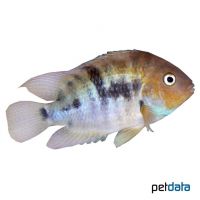T-Bar Cichlid (Amatitlania sajica)
| T-Bar Cichlid Amatitlania sajica | |
|---|---|
| Name | T-Bar Cichlid |
| Name Lat. | Amatitlania sajica |
| Synonym | Cryptoheros sajica |
| Family | Cichlids |
| Family lat. | Cichlidae |
| Order | Cichlids |
| Order lat. | Cichliformes |
| Origin | Costa Rica |
| Habitat | Streams, rivers |
| Diet | Omnivore |
| pH | 6.5-8.0 |
| Behavior | ♂ territorial |
| Keeping | Pair, group |
| Care Level | Moderate |
| Reproduction | Cave spawner |
| Breeding | Moderately difficult |
| Life Span | 7-10 years |
| Protection | No |
| Metric Units | |
| Size | 9-12 cm |
| Temperature | 22-26 °C |
| Hardness | 10-15 °dH |
| Aquarium | ~ 250 l |
| US Units | |
| Size | 3.5"-5" |
| Temperature | 72-79 °F |
| Hardness | 178-267 ppm |
| Aquarium | ~ 65 gal |
Distribution and habitat
The Sajica cichlids are found on the Pacific side in the south of Costa Rica. There they live in streams and small rivers with weak to medium currents, where they find numerous shelter and hiding places, such as stones, roots and branches as well as a sandy-muddy bottom.
Maintenance
They need a well structured aquarium with a robust border planting, with numerous hiding places (stones, roots) and swimming space. A dark, sandy substrate covered with some foliage, a weak current and slightly dim light (floating plants) is ideal.
No ammonia, ammonium and nitrite should be detectable, the nitrate value should not exceed 100 mg/l. To ensure the water quality and oxygen content, a filter and heater adapted to the aquarium size is required, as well as lighting for the species-appropriate day-night rhythm of the animals.
Diet
The food supply consists of live, frozen and dry food. For a balanced diet, feed at least once a day with a high-quality dry food for cichlids (flakes, granules, pellets) as well as artemia, mysis, tubifex, mosquito larvae, etc. (live or frozen). In addition, they occasionally need vegetable food, such as algae leaves, algae wafers or dry food with vegetable ingredients.
It is recommended to feed small portions several times a day, which are eaten within a few minutes. A regular and varied diet promotes health and increases resistance.
Behaviour and compatibility
It is recommended to keep them in pairs or in a group. They are a relatively peaceful species and behave territorially only during mating and spawning season. Keeping a group is only recommended in a larger and richly structured tank. They should only be socialized with other robust fish. Fish that are too small are considered prey.
Basically, only compatible fish species with similar demands on water quality and water temperature should be socialized.
Sex dimorphism
The larger males have a forehead hump and wine-red fins. With some experience, adolescent animals can be distinguished by their genital papilla, which is pointed in the male and ends bluntly in the female.
Reproduction and breeding
They spawn in a burrow or a sloping, often vertical hard substrate (e.g. stone). The female performs brood care, while the male defends the territory (parental family). After 3-4 days, the fry hatch and are then housed and guarded in a bottom pit prepared outside the cave until they swim freely after 5-7 days. Often the school of fry is guarded by the parents for a few more days.
Fry must be fed several times a day with special rearing food (e.g. Artemia nauplii). in community tanks breeding is hardly possible, because the fry are easy prey.
Important
They like to burrow, but hardly damage the plants.
The well-being of the fish should be checked regularly. The temperature should be checked daily, the pH, hardness and nitrate value at least every 14 days. Regular partial water changes are recommended, even if the pollutant load has not yet reached the upper limit. Sudden changes in water quality should be avoided. Newly introduced fish must be accustomed slowly to the water in the aquarium.
Further literature can be found in your pet store.
References
Text: Werner Winter; Image: petdata
Source: BMEL (1998): Tierschutzgutachten - Haltung von Zierfischen (Süßwasser); BAENSCH & RIEHL (2004): Aquarien Atlas Bd. 2, Mergus Verlag; ENGELMANN (2005): Zootierhaltung - Tiere in menschlicher Obhut: Fische, Verlag Harri Deutsch
- Gemäß § 21 Abs. 5 Tierschutzgesetz idgF
